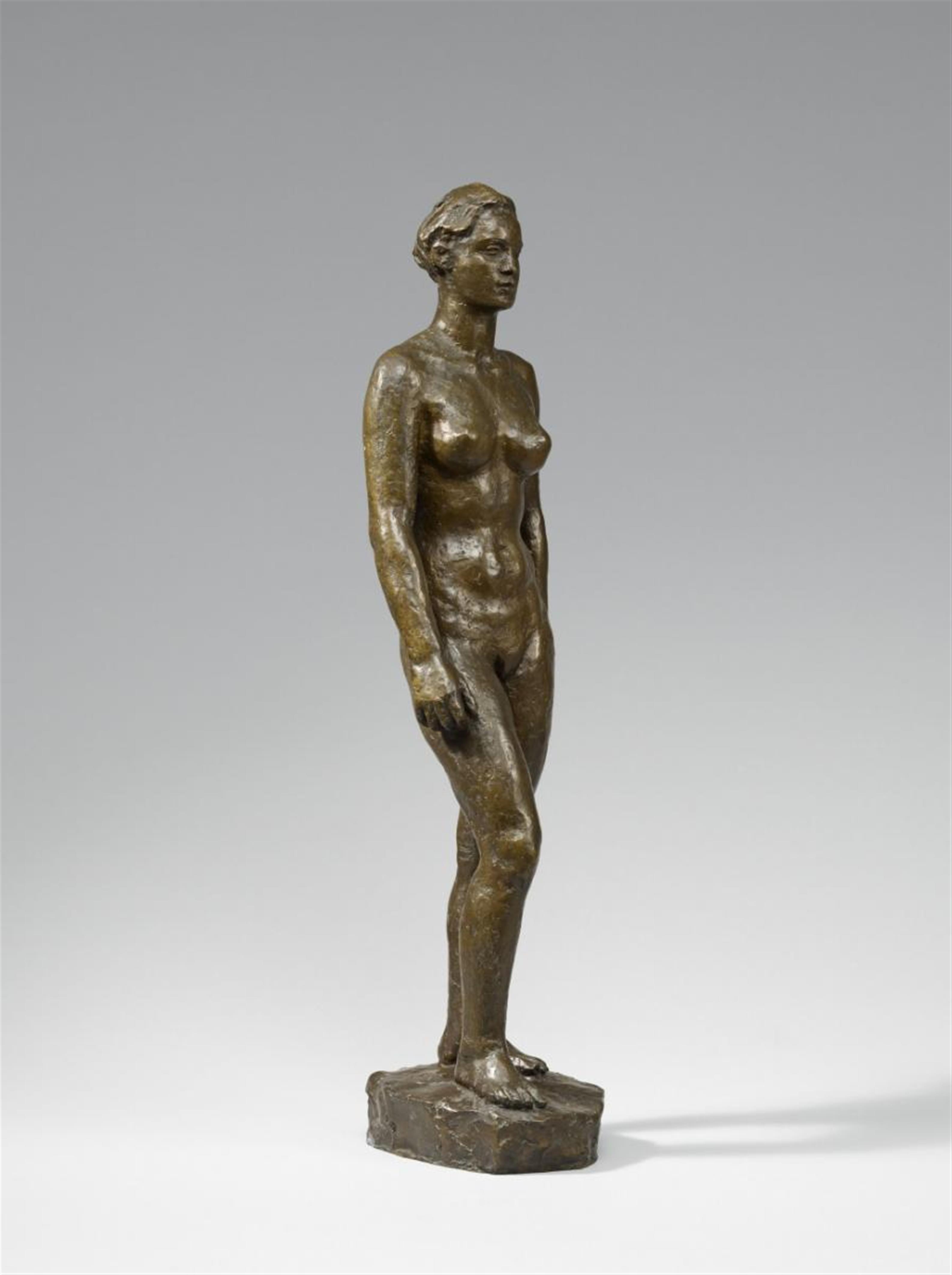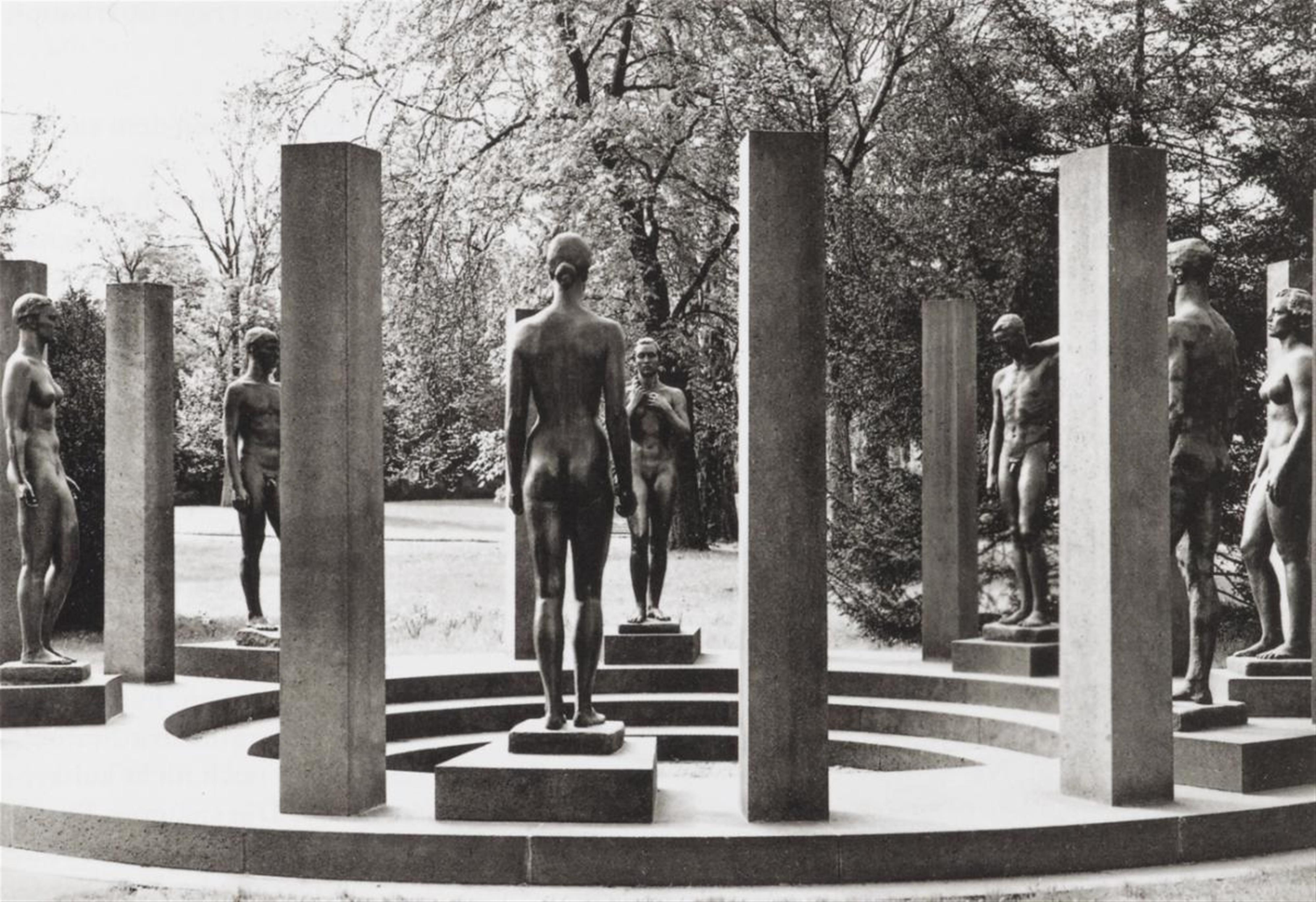Georg Kolbe
Kleine Stehende (Renate)
1935/1936
Bronze Height 78.3 cm Monogrammed 'GK' (joined) on back of cast-with, irregularly formed plinth to left. On reverse upper edge of plinth with the foundry mark "H.NOACK/ BERLIN FRIEDENAU". One of only 2 known casts, the first one in the Georg Kolbe Museum in Berlin. According to documentation available in the Kolbe archive, this second cast was made for the Galerie Buchholz in Berlin in October 1936 and soon after exported by the gallery to its New York branch. For this purpose, according to information by Ursel Berger, the number "1" was applied to the plinth below the foundry mark; normally, Georg Kolbe's casts were not numbered; only for export reasons they received such stamped marks, which were not consecutive exemplar numbers. - Even, fine bronze patina with greenish-olive-coloured tinge.
According to Ursel Berger, the dancer Renate Löwy (also: Levi) served as the artist's model for this bronze.
From the very beginning, Kolbe's oeuvre is unmistakably dominated by the female nude. In the 1930s and 1940s the nude was invested with lifelike and fuller proportions in comparison to the delicate, girlish figures of his early work; a new, suggestively classical formal simplification can also be noted. Outward movements as well as inner agitation have become markedly more reserved: basic positions of the body predominate and the emotions have been calmed. In spite of the naturalism and vitality of the modelled surface of Georg Kolbe's figures, there is an unmistakable monumentalising tendency. His occupation with the standing female nude led the artist from the 1929/1930 “Frauenstatue” (Statue of a Woman; Berger 125) - created in memory of his wife Benjamine Kolbe, who had died in 1927 - to the 1933 “Jungmädchen (Junges Mädchen)” (Young Girl; Berger 151) and the 1937 “Amazone (Junge Frau)” (Amazon [Young Woman]; Berger 170). At 106 cm and 94 cm, the latter two sculptures are significantly larger than the so-called “Kleine Stehende” (Small Standing Figure) here. The figure of "Jungmädchen" has been created, though, according to Berger's latest research, after the same model as mentioned above.
“Kolbe's journey to Greece in 1931 may have facilitated his turning to the statuesque. In addition, younger sculptors like Gerhard Marcks, Ludwig Kasper and Hermann Blumenthal also preferred to occupy themselves with stately, standing figures at that time - these were, however, given a more abstract form in comparison to Kolbe's figures. In the mid thirties, Kolbe had overcome some awkward aspects of the period in his work around 1930. He created several figures which unite dignity and beauty within themselves. It is the female figures which make a particularly convincing impression and which were obviously more extensively reworked at the stage of the full-scale model than the repetitive male figures of athletes. All of them are connected with the 'Ring der Statuen' [Ring of Statues] project, which Kolbe had at one point conceived of as a 'Ring der Frauen' [Ring of Women]” (Ursel Berger, Georg Kolbe - Leben und Werk, Berlin 1990, p. 116). Kolbe had been occupied with this “Ring” project since 1933: it was connected with architectonic-sculptural designs for a planned Nietzsche monument in Weimar. The installation of a ring of statues of this kind, featuring four female and three male figures, was finally realised only after the Second World War, in Frankfurt's Rothschild-Park (Berger, op. cit., p. 117; cf. also Ursel Berger (ed.), Georg Kolbe, exhib. cat. Berlin/Bremen 1998, pp. 68 f. and 117 with illus.; see also our comparative illus.).
In the present figure of the “Kleine Stehende”, the calm pose is animated through the slight shifting of the hips and through the contrasting movements of the two halves of the body. The right leg is placed in front and the right arm brought forward slightly; the hand rests on the extended thigh. On the left side, the weight-bearing leg and the arm form a stable vertical, and the left hand is opened towards the back in a natural gesture. The present figure is depicted in a way that avoids classicistic smoothness and frontal symmetry, which are often perceived as hierarchic and severe in the case of comparable nudes from this period. However, athletic youthfulness and modern self-confidence are expressed in the upright pose and the regular features of the model.
Catalogue Raisonné
Berger 157
Certificate
With an expertise by Ursel Berger, Berlin, dated 5 May 2014
Provenance
Galerie Buchholz, Berlin (1936); Buchholz Gallery, New York (1937); M. Knoedler & Co., Inc., New York (1968); Deane F. Johnson, Beverly Hills; Private possession, USA; Christie's New York, Impressionist and Modern Art, sale 2439, May 5, 2011, lot 382; Private possession, North Germany
Literature
Ursel Berger, Georg Kolbe - Leben und Werk, mit dem Katalog der Kolbe-Plastiken im Georg-Kolbe-Museum, Berlin 1990, pp. 351 f., cat. 157 with illus. p. 351; cf. also ibid. pp. 116 f.
Exhibitions
New York 1937 (Buchholz Gallery - Curt Valentin), Opening Exhibition: Sculpture and Drawings, March-April 1937, no. 12; New York 1938 (Buchholz Gallery - Curt Valentin), Georg Kolbe: Sculpture & Drawings, Feb. 14 - March 12, 1938, no. 25




